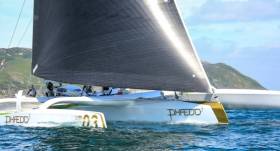Displaying items by tag: Lloyd Thornburg
Last night, National Yacht Club Commodore Larry Power presented American yachtsman Llyod Thornburg and the crew of Phaedo 3, with the Cork Dry Gin Round Ireland Record Perpetual trophy for August's record breaking run. A dinner to celebrate the new Round Ireland Speed Record followed at the Dun Laoghaire clubhouse. Irish World Speed Sailing Commissioner Chris Moore attended.
Thornburg set the new record in his 70–foot trimaran Phaedo 3 just a month after a new record was made by rival MOD 70 Oman Sail. Phaedo 3 crossed the Kish lighthouse start/finish line at Dún Laoghaire, at 04.01.04am on Friday, 5th August 2016, beating the previous world record by approximately 1 hours and 45 minutes.
The 36 hours and 52 minutes time was later ratified by the World Speed Sailing Record Council.
All crew members who were onboard for the world record run attended last night's dinner, including County Kerry's Damian Foxall.
Round Ireland Speed Record Breaker Phaedo3 Takes Line Honours In Tenth Artemis Challenge
Round Ireland speed sailing record breaker Phaedo3 skipper Lloyd Thornburg, who will be at the National Yacht Club tonight to celebrate that circumnavigation, picked up another prize yesterday when the American took line honours in the tenth edition of the Artemis Challenge at Aberdeen Asset Management Cowes Week.
Screaming around the Isle of Wight at top speeds of over 30 knots, Thornburg's MOD70 covered the 50 nautical mile course in three hours and 56 seconds, 50 minutes ahead of M32 Tranwall.
Powering over the Royal Yacht Squadron start line in a flash of gold and white, Phaedo3 flew past the Needles at 27 knots. Executing just three tacks the along the north west coast past Yarmouth, the boat was on pace with the world record holder Foncia.
Despite their rapid speed and sheer determination, light conditions on the south east side of the Island put paid to any record breaking runs, with the current world record set by Michel Desjoyeaux and Foncia in the 2012 edition of the race out of reach at two hours, 21 minutes and 25 seconds.
Despite the sheer size of Phaedo3, M32 Tranwall was hot on the stern of the MOD70. On the approach to Saint Catherine's lighthouse, the 32-foot match-racing catamaran achieved speeds of 21 knots and was just five miles behind the ocean racing giant - not bad for a catamaran measuring in at less than half the size of the giant trimaran's hulls.
In what was the first time an M32 has competed in the Artemis Challenge, the Tranwall crew set their own benchmark today, completing the charity sprint in three hours, 58 minutes and one second.
Round Ireland Speed Record Tracker CLICK HERE!
Track the Round Ireland speed record attempt by the MOD70 Phaedo3 Lloyd Thornburg below.
The record time to beat is: 38 hours, 37 minutes and 7 seconds.
Stay tuned to the Yellowbrick tracker below.































































